Reading List
Terminal colours are tricky from Julia Evans RSS feed.
Terminal colours are tricky
Yesterday I was thinking about how long it took me to get a colorscheme in my terminal that I was mostly happy with (SO MANY YEARS), and it made me wonder what about terminal colours made it so hard.
So I asked people on Mastodon what problems they’ve run into with colours in the terminal, and I got a ton of interesting responses! Let’s talk about some of the problems and a few possible ways to fix them.
problem 1: blue on black
One of the top complaints was “blue on black is hard to read”. Here’s an
example of that: if I open Terminal.app, set the background to black, and run
ls, the directories are displayed in a blue that isn’t that easy to read:

To understand why we’re seeing this blue, let’s talk about ANSI colours!
the 16 ANSI colours
Your terminal has 16 numbered colours – black, red, green, yellow, blue, magenta, cyan, white, and “bright” version of each of those.
Programs can use them by printing out an “ANSI escape code” – for example if you want to see each of the 16 colours in your terminal, you can run this Python program:
def color(num, text):
return f"\033[38;5;{num}m{text}\033[0m"
for i in range(16):
print(color(i, f"number {i:02}"))
what are the ANSI colours?
This made me wonder – if blue is colour number 5, who decides what hex color that should correspond to?
The answer seems to be “there’s no standard, terminal emulators just choose colours and it’s not very consistent”. Here’s a screenshot of a table from Wikipedia, where you can see that there’s a lot of variation:

problem 1.5: bright yellow on white
Bright yellow on white is even worse than blue on black, here’s what I get in a terminal with the default settings:

That’s almost impossible to read (and some other colours like light green cause similar issues), so let’s talk about solutions!
two ways to reconfigure your colours
If you’re annoyed by these colour contrast issues (or maybe you just think the default ANSI colours are ugly), you might think – well, I’ll just choose a different “blue” and pick something I like better!
There are two ways you can do this:
Way 1: Configure your terminal emulator: I think most modern terminal emulators have a way to reconfigure the colours, and some of them even come with some preinstalled themes that you might like better than the defaults.
Way 2: Run a shell script: There are ANSI escape codes that you can print
out to tell your terminal emulator to reconfigure its colours. Here’s a shell script that does that,
from the base16-shell project.
You can see that it has a few different conventions for changing the colours –
I guess different terminal emulators have different escape codes for changing
their colour palette, and so the script is trying to pick the right style of
escape code based on the TERM environment variable.
what are the pros and cons of the 2 ways of configuring your colours?
I prefer to use the “shell script” method, because:
- if I switch terminal emulators for some reason, I don’t need to a different configuration system, my colours still Just Work
- I use base16-shell with base16-vim to make my vim colours match my terminal colours, which is convenient
some advantages of configuring colours in your terminal emulator:
- if you use a popular terminal emulator, there are probably a lot more nice terminal themes out there that you can choose from
- not all terminal emulators support the “shell script method”, and even if they do, the results can be a little inconsistent
This is what my shell has looked like for probably the last 5 years (using the
solarized light base16 theme), and I’m pretty happy with it. Here’s htop:
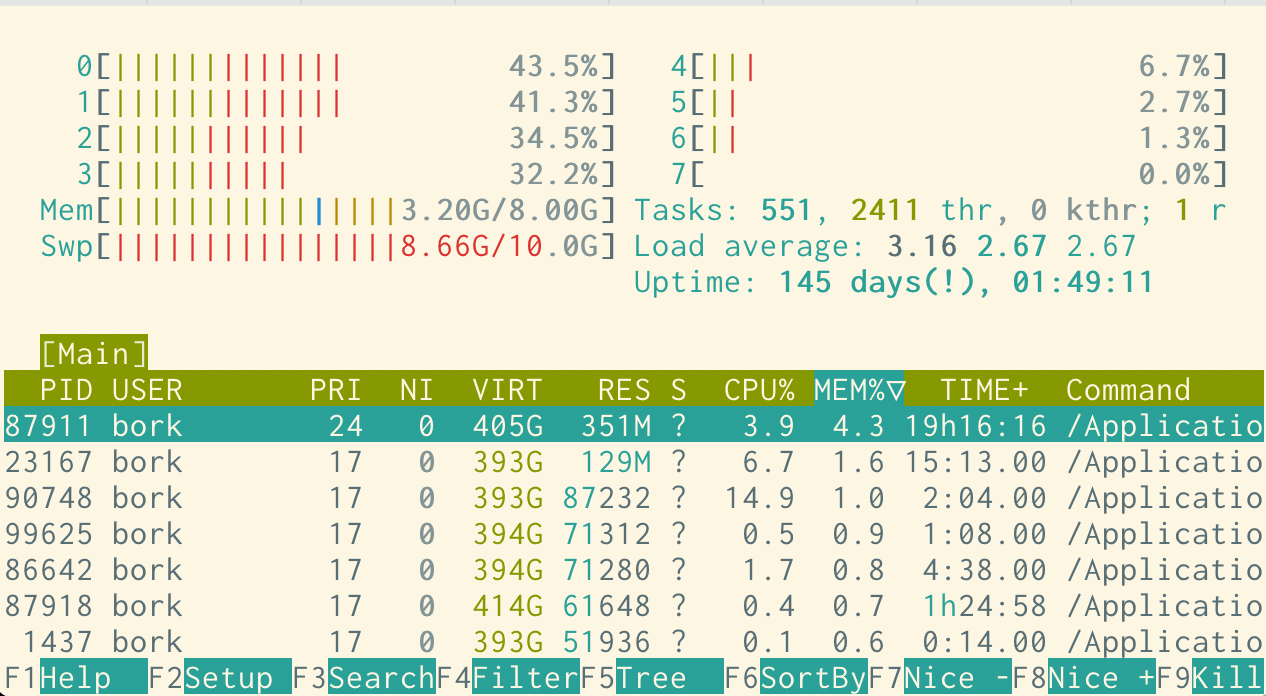
Okay, so let’s say you’ve found a terminal colorscheme that you like. What else can go wrong?
problem 2: programs using 256 colours
Here’s what some output of fd, a find alternative, looks like in my
colorscheme:

The contrast is pretty bad here, and I definitely don’t have that lime green in my normal colorscheme. What’s going on?
We can see what color codes fd is using using the unbuffer program to
capture its output including the color codes:
$ unbuffer fd . > out
$ vim out
^[[38;5;48mbad-again.sh^[[0m
^[[38;5;48mbad.sh^[[0m
^[[38;5;48mbetter.sh^[[0m
out
^[[38;5;48 means “set the foreground color to color 48”. Terminals don’t
only have 16 colours – many terminals these days actually have 3 ways of
specifying colours:
- the 16 ANSI colours we already talked about
- an extended set of 256 colours
- a further extended set of 24-bit hex colours, like
#ffea03
So fd is using one of the colours from the extended 256-color set. bat (a
cat alternative) does something similar – here’s what it looks like by
default in my terminal.
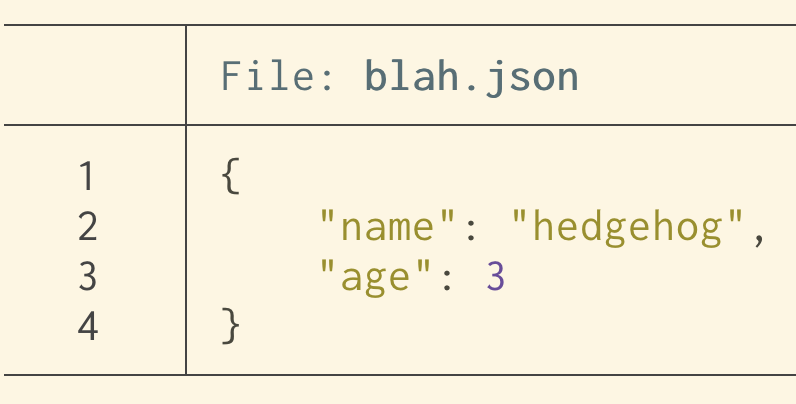
This looks fine though and it really seems like it’s trying to work well with a variety of terminal themes.
some newer tools seem to have theme support
I think it’s interesting that some of these newer terminal tools (fd, cat,
delta, and probably more) have support for arbitrary custom themes. I guess
the downside of this approach is that the default theme might clash with your
terminal’s background, but the upside is that it gives you a lot more control
over theming the tool’s output than just choosing 16 ANSI colours.
I don’t really use bat, but if I did I’d probably use bat --theme ansi to
just use the ANSI colours that I have set in my normal terminal colorscheme.
problem 3: the grays in Solarized
A bunch of people on Mastodon mentioned a specific issue with grays in the Solarized theme: when I list a directory, the base16 Solarized Light theme looks like this:

but iTerm’s default Solarized Light theme looks like this:

This is because in the iTerm theme (which is the original Solarized design), colors 9-14 (the “bright blue”, “bright
red”, etc) are mapped to a series of grays, and when I run ls, it’s trying to
use those “bright” colours to color my directories and executables.
My best guess for why the original Solarized theme is designed this way is to make the grays available to the vim Solarized colorscheme.
I’m pretty sure I prefer the modified base16 version I use where the “bright” colours are actually colours instead of all being shades of gray though. (I didn’t actually realize the version I was using wasn’t the “original” Solarized theme until I wrote this post)
In any case I really love Solarized and I’m very happy it exists so that I can use a modified version of it.
problem 4: a vim theme that doesn’t match the terminal background
If I my vim theme has a different background colour than my terminal theme, I get this ugly border, like this:

This one is a pretty minor issue though and I think making your terminal background match your vim background is pretty straightforward.
problem 5: programs setting a background color
A few people mentioned problems with terminal applications setting an unwanted background colour, so let’s look at an example of that.
Here ngrok has set the background to color #16 (“black”), but the
base16-shell script I use sets color 16 to be bright orange, so I get this,
which is pretty bad:
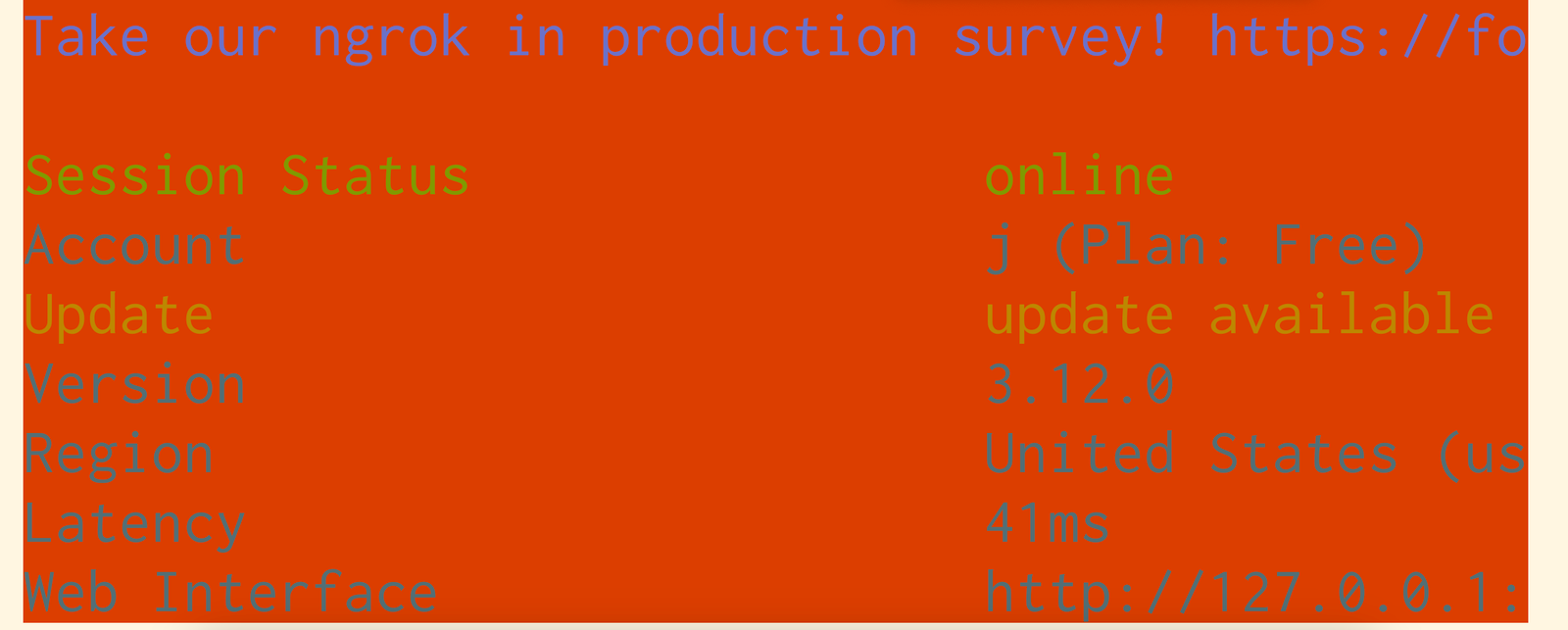
I think the intention is for ngrok to look something like this:

I think base16-shell sets color #16 to orange (instead of black)
so that it can provide extra colours for use by base16-vim.
This feels reasonable to me – I use base16-vim in the terminal, so I guess I’m
using that feature and it’s probably more important to me than ngrok (which I
rarely use) behaving a bit weirdly.
This particular issue is a maybe obscure clash between ngrok and my colorschem, but I think this kind of clash is pretty common when a program sets an ANSI background color that the user has remapped for some reason.
a nice solution to contrast issues: “minimum contrast”
A bunch of terminals (iTerm2, tabby, kitty’s text_fg_override_threshold, and folks tell me also Ghostty and Windows Terminal) have a “minimum contrast” feature that will automatically adjust colours to make sure they have enough contrast.
Here’s an example from iTerm. This ngrok accident from before has pretty bad contrast, I find it pretty difficult to read:

With “minimum contrast” set to 40 in iTerm, it looks like this instead:

I didn’t have minimum contrast turned on before but I just turned it on today because it makes such a big difference when something goes wrong with colours in the terminal.
problem 6: TERM being set to the wrong thing
A few people mentioned that they’ll SSH into a system that doesn’t support the
TERM environment variable that they have set locally, and then the colours
won’t work.
I think the way TERM works is that systems have a terminfo database, so if
the value of the TERM environment variable isn’t in the system’s terminfo
database, then it won’t know how to output colours for that terminal. I don’t
know too much about terminfo, but someone linked me to this terminfo rant that talks about a few other
issues with terminfo.
I don’t have a system on hand to reproduce this one so I can’t say for sure how
to fix it, but this stackoverflow question
suggests running something like TERM=xterm ssh instead of ssh.
problem 7: picking “good” colours is hard
A couple of problems people mentioned with designing / finding terminal colorschemes:
- some folks are colorblind and have trouble finding an appropriate colorscheme
- accidentally making the background color too close to the cursor or selection color, so they’re hard to find
- generally finding colours that work with every program is a struggle (for example you can see me having a problem with this with ngrok above!)
problem 8: making nethack/mc look right
Another problem people mentioned is using a program like nethack or midnight commander which you might expect to have a specific colourscheme based on the default ANSI terminal colours.
For example, midnight commander has a really specific classic look:
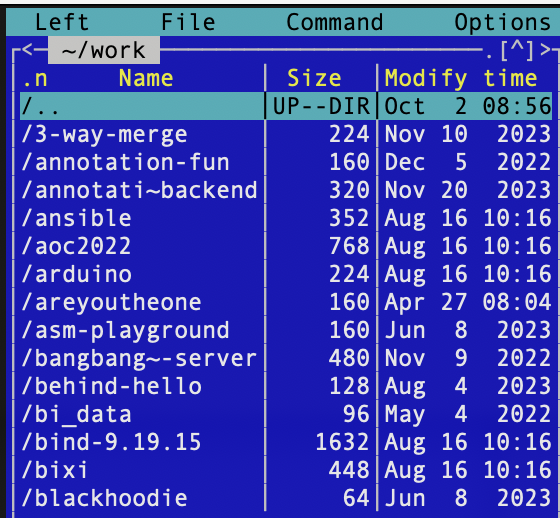
But in my Solarized theme, midnight commander looks like this:

The Solarized version feels like it could be disorienting if you’re very used to the “classic” look.
One solution Simon Tatham mentioned to this is using some palette customization ANSI codes (like the ones base16 uses that I talked about earlier) to change the color palette right before starting the program, for example remapping yellow to a brighter yellow before starting Nethack so that the yellow characters look better.
problem 9: commands disabling colours when writing to a pipe
If I run fd | less, I see something like this, with the colours disabled.
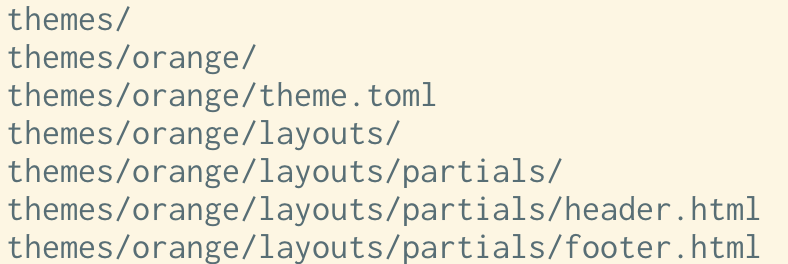
In general I find this useful – if I pipe a command to grep, I don’t want it
to print out all those color escape codes, I just want the plain text. But what if you want to see the colours?
To see the colours, you can run unbuffer fd | less -r! I just learned about
unbuffer recently and I think it’s really cool, unbuffer opens a tty for the
command to write to so that it thinks it’s writing to a TTY. It also fixes
issues with programs buffering their output when writing to a pipe, which is
why it’s called unbuffer.
Here’s what the output of unbuffer fd | less -r looks like for me:
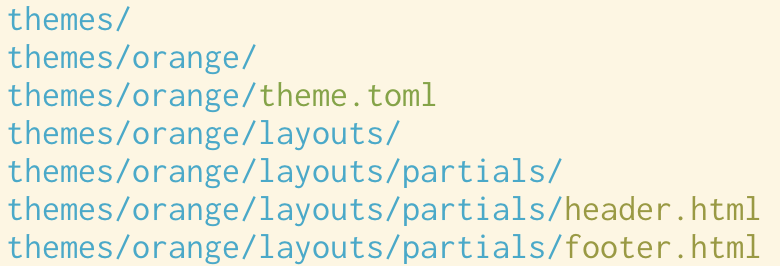
Also some commands (including fd) support a --color=always flag which will
force them to always print out the colours.
problem 10: unwanted colour in ls and other commands
Some people mentioned that they don’t want ls to use colour at all, perhaps
because ls uses blue, it’s hard to read on black, and maybe they don’t feel like
customizing their terminal’s colourscheme to make the blue more readable or
just don’t find the use of colour helpful.
Some possible solutions to this one:
- you can run
ls --color=never, which is probably easiest - you can also set
LS_COLORSto customize the colours used byls. I think some other programs other thanlssupport theLS_COLORSenvironment variable too. - also some programs support setting
NO_COLOR=true(there’s a list here)
Here’s an example of running LS_COLORS="fi=0:di=0:ln=0:pi=0:so=0:bd=0:cd=0:or=0:ex=0" ls:

problem 11: the colours in vim
I used to have a lot of problems with configuring my colours in vim – I’d set up my terminal colours in a way that I thought was okay, and then I’d start vim and it would just be a disaster.
I think what was going on here is that today, there are two ways to set up a vim colorscheme in the terminal:
- using your ANSI terminal colours – you tell vim which ANSI colour number to use for the background, for functions, etc.
- using 24-bit hex colours – instead of ANSI terminal colours, the vim colorscheme can use hex codes like #faea99 directly
20 years ago when I started using vim, terminals with 24-bit hex color support were a lot less common (or maybe they didn’t exist at all), and vim certainly didn’t have support for using 24-bit colour in the terminal. From some quick searching through git, it looks like vim added support for 24-bit colour in 2016 – just 8 years ago!
So to get colours to work properly in vim before 2016, you needed to synchronize
your terminal colorscheme and your vim colorscheme. Here’s what that looked like,
the colorscheme needed to map the vim color classes like cterm05 to ANSI colour numbers.
But in 2024, the story is really different! Vim (and Neovim, which I use now)
support 24-bit colours, and as of Neovim 0.10 (released in May 2024), the
termguicolors setting (which tells Vim to use 24-bit hex colours for
colorschemes) is turned on by default in any terminal with 24-bit
color support.
So this “you need to synchronize your terminal colorscheme and your vim colorscheme” problem is not an issue anymore for me in 2024, since I don’t plan to use terminals without 24-bit color support in the future.
The biggest consequence for me of this whole thing is that I don’t need base16
to set colors 16-21 to weird stuff anymore to integrate with vim – I can just
use a terminal theme and a vim theme, and as long as the two themes use similar
colours (so it’s not jarring for me to switch between them) there’s no problem.
I think I can just remove those parts from my base16 shell script and totally
avoid the problem with ngrok and the weird orange background I talked about
above.
some more problems I left out
I think there are a lot of issues around the intersection of multiple programs, like using some combination tmux/ssh/vim that I couldn’t figure out how to reproduce well enough to talk about them. Also I’m sure I missed a lot of other things too.
base16 has really worked for me
I’ve personally had a lot of success with using
base16-shell with
base16-vim – I just need to add a couple of lines to my
fish config to set it up (+ a few .vimrc lines) and then I can move on and
accept any remaining problems that that doesn’t solve.
I don’t think base16 is for everyone though, some limitations I’m aware of with base16 that might make it not work for you:
- it comes with a limited set of builtin themes and you might not like any of them
- the Solarized base16 theme (and maybe all of the themes?) sets the “bright” ANSI colours to be exactly the same as the normal colours, which might cause a problem if you’re relying on the “bright” colours to be different from the regular ones
- it sets colours 16-21 in order to give the vim colorschemes from
base16-vimaccess to more colours, which might not be relevant if you always use a terminal with 24-bit color support, and can cause problems like the ngrok issue above - also the way it sets colours 16-21 could be a problem in terminals that don’t have 256-color support, like the linux framebuffer terminal
Apparently there’s a community fork of base16 called tinted-theming, which I haven’t looked into much yet.
some other colorscheme tools
Just one so far but I’ll link more if people tell me about them:
- rootloops.sh for generating colorschemes (and “let’s create a terminal color scheme”)
- Some popular colorschemes (according to people I asked on Mastodon): catpuccin, Monokai, Gruvbox, Dracula, Modus (a high contrast theme), Tokyo Night, Nord, Rosé Pine
okay, that was a lot
We talked about a lot in this post and while I think learning about all these details is kind of fun if I’m in the mood to do a deep dive, I find it SO FRUSTRATING to deal with it when I just want my colours to work! Being surprised by unreadable text and having to find a workaround is just not my idea of a good day.
Personally I’m a zero-configuration kind of person and it’s not that appealing to me to have to put together a lot of custom configuration just to make my colours in the terminal look acceptable. I’d much rather just have some reasonable defaults that I don’t have to change.
minimum contrast seems like an amazing feature
My one big takeaway from writing this was to turn on “minimum contrast” in my terminal, I think it’s going to fix most of the occasional accidental unreadable text issues I run into and I’m pretty excited about it.